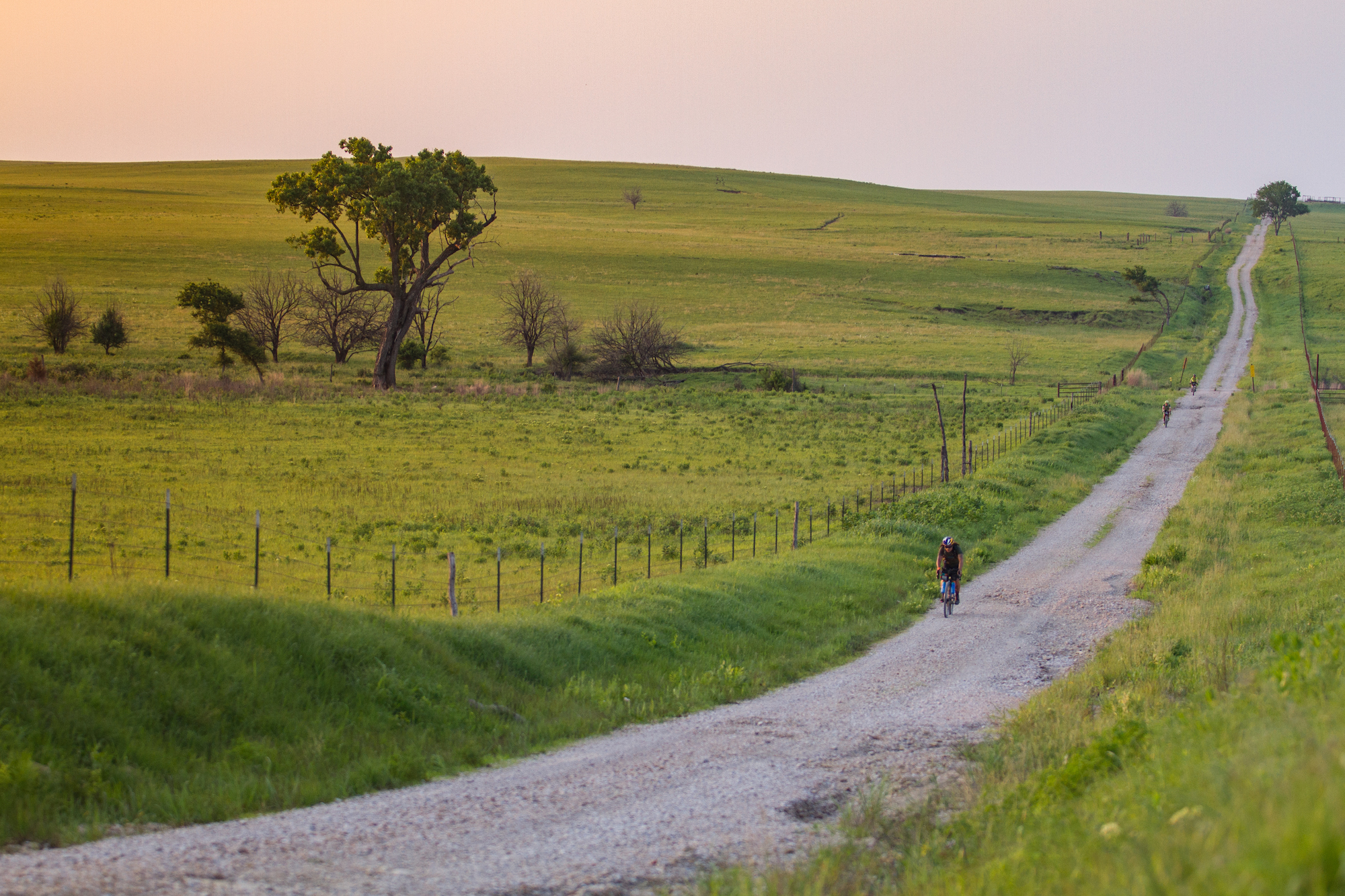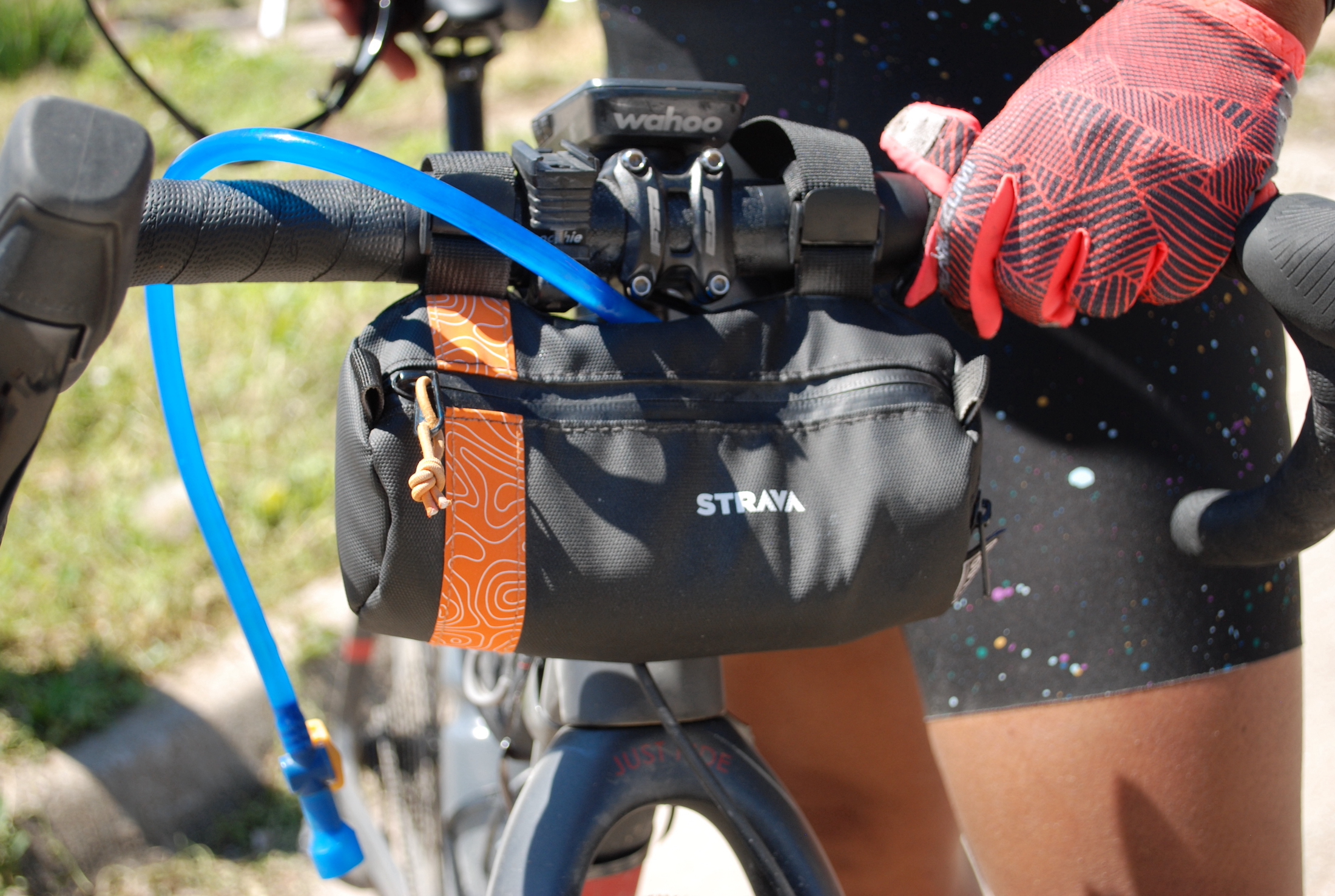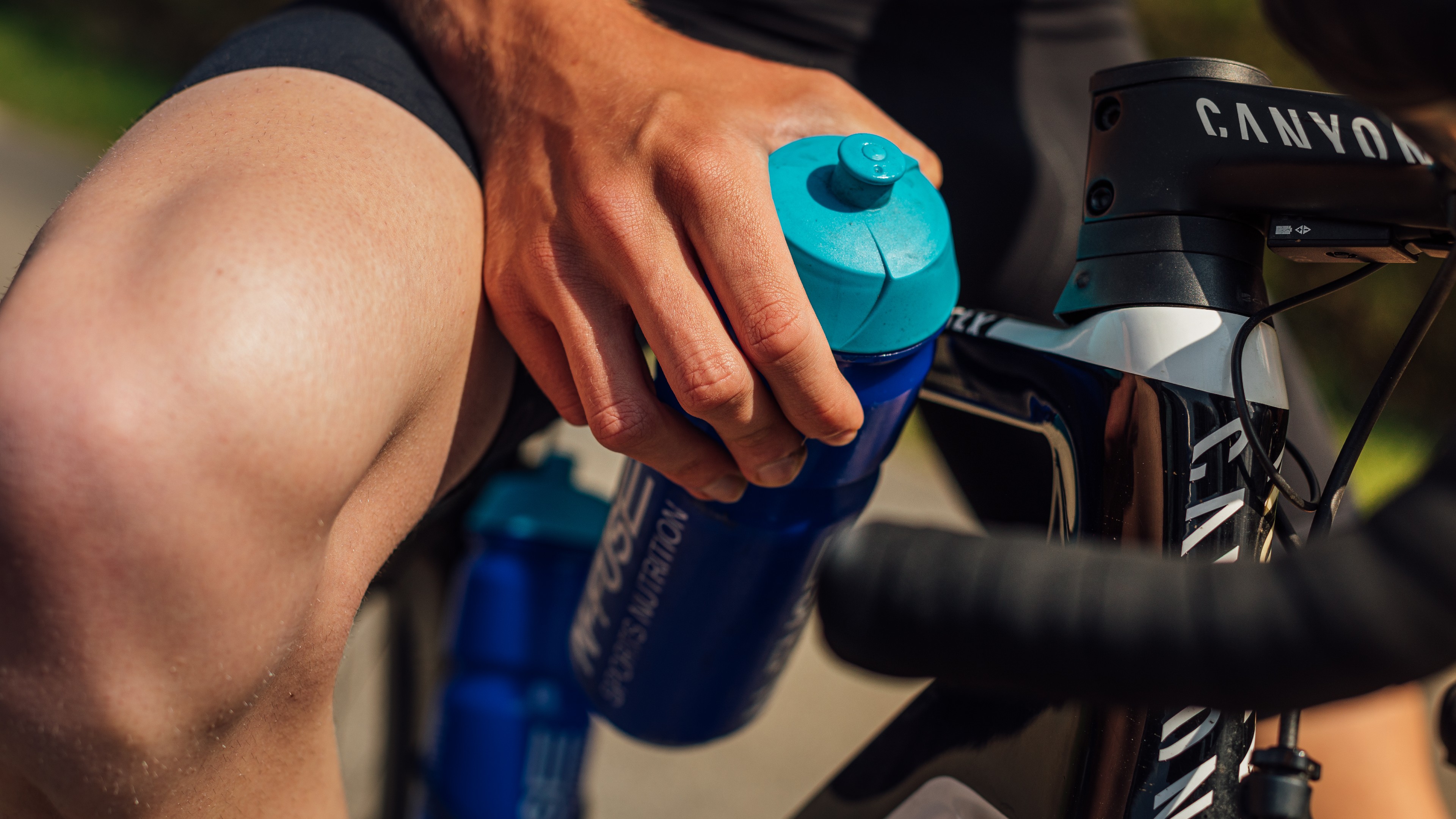
We've all been there. You signed up for an event in winter, thinking that this will be the year that all the stars align and you will find your best fitness yet. But then, all of a sudden, the event is here, and it's go-time.
Now that Unbound is just days away, we can’t help you bank the miles, but we can provide you with some last-minute tips on getting your fueling right for the big day.
Whether you're doing the 100-, 200- or 350-miler, Unbound is a challenge of endurance, self-sufficiency and equipment. The relentless undulating terrain, sharp flint rocks, and soul-sucking mud or sun-baked roads will test your mindset, tires and gear. At the same time, you must take care of the machine —your body— fueling it properly to tick off mile after mile.
We reached out to a few gravel pros with the ultimate Unbound Gravel experience —the 200- and 350-milers— for some tips on nutrition and fueling strategies.
How to properly fuel your body when riding (ultra)long distances

You have to respect the distance. This isn't a traditional race. It's wholly different, and you don't know how your body's going to respond. And that, I think, is the cool part
Maxx Chance, 11th place Unbound XL 2022
Your body is like a steam engine locomotive. You need to burn coals —calories— to power the engine and keep the train moving forward.
The cut-off times for the 100-, 200- and 350-mile Unbound event are 10 hours, 20 hours and 36 hours, respectively. For some riders out on course, Unbound is a race against time, and they’ll need every single minute of the time allotted to them to successfully reach the finish line in Emporia, Kansas. That is a lot of hours spent in the saddle, stoking the engine and consuming fuel.
Just how much fuel?

In 2021, pro gravel racer Alexey Vermeulen drank 2800 liquid calories, ate another 700 calories, and drank over 7 liters of plain water to complete the 200-mile event in 11 hours and 29 minutes. For those tackling the XL event, the calories required is at least twice that.
Chance says he consumed 960 liquid calories between every refilling opportunity at every 75 miles or so. That makes for almost 4500 liquid calories alone. He then supplemented that with solid foods from the gas stations.
Ultra-distance icon, Rebecca Rusch, has three Unbound Gravel 200 titles as well as one Unbound XL win among her many accolades. The Gravel Hall of Famer has mastered the art of fueling her body and tells Cycling Weekly that she subscribes to the basic guideline of 200 calories and 20 ounces of water per hour.
"It takes a lot of discipline because, in really long events, you don't want to eat. It's no longer fun or joyful. It's a job. And you're probably going to be burning more than that in an endurance event, but your gut really can't take much more," she says.
Yuri Hauswald, an early adopter of the gravel movement, won the 200-mile race at Unbound in 2015 at the age of 45 and finished second in the longer Unbound XL three years later. He, too, goes off the 200 calories per hour guideline.
"I shoot for at least 200 calories if I can because you're going to be operating at a caloric deficit that whole time. And the deeper that hole goes, the harder it is for you to keep shoveling it in," he said. "Rebecca Rush and I call it the Sip, sip, nibble, nibble —where you're just constantly taking in little bits of food and hydration."
Sip, sip, nibble, nibble: How and what to consume to keep the legs moving

Stop at the aid or gas stations
In order to consume enough calories, you have to eat and drink often and a lot. For most of the race distances, there are aid stations where riders can refill their supplies. It's not mandatory to stop; one could opt to carry their necessities on their bike, but if we were to follow the guideline of 20 ounces of water per hour, you'd be carrying a lot of extra weight around. The fastest 100-mile time was just over 5 hours in 2022, which would mean slogging 6.25 pounds (2.8 kilos) of water around. And that does not include any food.
"You honestly cannot carry enough to get through the race without filling up, in my opinion," Vermeulen says and encourages all riders to take the time to stop at the provided aid stations, even if it feels odd to stop mid-race.
In the fully self-supported 350-mile event, however, there are no official aid stations. Riders need to carry a large amount of fuel on their bikes and rely on the few available gas stations to refill along the way.
"The gas stations are your life source," Rusch said. "They are your only fuel source, and once you roll away from there, you're on your own."
Set an alarm
If you’re having trouble eating, a simple but effective way to stay on top of your nutrition is to set an alarm, says Rusch.
"When you're doing something this long, eating becomes a discipline. So set an alarm as a reminder to eat. Even if you're not hungry, you feel fine; putting that food in your mouth will pay off."
If you put garbage in, you're going to get garbage energy out

Haribo, chews, chips, and peanut M&Ms are common at endurance events. Quick, simple, and tasty carbs are good because calories are calories, right? Yes and no.
“Before biking, when I was doing these weeklong adventure races like the Eco Challenge, I used to believe that I was going so long and so hard that I could eat whatever I wanted, whether it was pizza or Swedish Fish [a popular chewy sweet in the US]. And I did, but I have since adapted," Rusch reveals.
“If you put garbage in, you're going to get garbage energy out. That said, it's not to say I wouldn't eat gummy bears or whatever, but it's not going to be the staple.”
Instead, Rusch devises a menu plan for each event she undertakes based on time in the saddle and weather.
"The couple hundred calories and one water bottle is where I start. Then, I look at macronutrients and micronutrients, so carbs, fat, and protein. I consider that basically the gas that's going into the car," she explains.
"Carbs are our main fuel source, consisting of high and low glycemic or fast-burning and longer-burning carbs. And then fat and protein are the really long burning fuel, like putting a big old log on the fire instead of a bunch of kindling and twigs."
The micronutrients, Rusch says, are like the oil in your car. You may need smaller quantities, but they're important to keep things running smoothly. These include electrolytes, minerals, and vitamins.
Rusch is the first to admit that when eating itself becomes a chore, considering macro- and micronutrients is far from one’s mind.
“Sometimes you're just going to have happy food that tastes good but maybe has no nutrient value for you, but you're going to eat it anyway because it's the middle of the night and you're crying and you want to eat gummy bears. That's fine, too, but again, it can’t be the staple.”
So how do these endurance athletes ensure they meet their nutrient requirements while staying happy?
Some, like Canadian gravel privateer Rob Britton, rely purely on sports nutrition. On his way to a sixth place finish in last year’s Unbound 200, the former pro road racer took in “as many bottles as I could get of EFS-PRO drink mix and consuming the remainder of my calories from a mix of Liquid Shots - likely three to four per hour."
For the longer distances, it's a balancing act of liquid calories and various solid, gas station snacks.
"It really comes down to water, sports nutrition, and whatever convenient store snacks resonate with you," says Hauswald.
Liquid Calories, the staple

Be it First Endurance’s EFS Hydration Mix, Gu's Roctane Energy Drink Mix, or Skratch Labs' Super High-Carb Sports Mix, all the racers interviewed rely heavily on liquid calories.
“I would say that the high-carb drink mix stuff was a total game changer for me,” says Chance, who drank most of his calories.
"I had a half-sized frame bag that fits a liter and a half [hydration bladder] and routed the hose with a magnetic clip to my bar. It gave me easy access. I had 960 calories in the bag, and those would last me like 50 to 60 miles. I didn't have to worry about consuming a gel every hour or anything like that because I knew I was getting my calories and hydration in just by drinking while moving."
Chance said he supplemented that with gas station foods. "I used the gas stations. I ate a slice of pizza at two in the morning and stuff like that, but my electrolytes and fuel were coming mostly from my drink mix."
Hauswald, too, relied on drink mixes for his events.
"I was relying on my tried-and-true Gu Roctane liquid calories, gels and then supplementing with some chews or some bars and something salty or tasty from the convenient store," he says. "I do have a specific memory of the last four or five hours of the XL event, and just going back to gels because I just wanted to be done."
The same goes for Rusch, who carries packets of drink mix because they're a reliable source of nutrients and don't weigh much. In between aid or gas stations, she'll take in some chews and other sports nutrition but values her time at the refueling opportunities for real food.
Pizza, nuts, and beef jerky - happy fuel

While sports nutrition may be the base of the riders' diet during long-distance events, convenience stores or aid stations play a significant role in keeping you happy and motivated to eat.
After hours of the same sweet and textureless sports nutrition, riders often get something called flavor fatigue — that feeling when you're sick and tired of consuming the same thing and, therefore, won't consume anything at all. The variety in offerings at the mid-race stops helps break up that monotony and give riders something to look forward to.
"Variety is key because your palette is going to change, and just having options that you can choose from through the event is good," says Hauswald. "Not just because you're going to get sick and tired of the same stuff, but a slice of pizza or a breakfast sandwich can also be a good carrot to have dangling out there —a dumb little trick you can play with yourself to get you to the next convenience store."
Chance says that for him, knowing he was getting the valuable nutrients from his drink mix, he’d simply wander the aisles until something spoke to him. Rusch, however, has a slightly more strategic approach.
"Gas stations are where it gets tricky, and you may play some Russian roulette with some hideous food choices. A lot of those processed foods have a lot of sodium and weird shit in them, and your body starts getting bloated, or you get gastrointestinal problems," she warns.
In situations where real food is not an option, Rusch's go-to is nuts, dates, and jerky. Foods that are calorically dense, semi-healthy, and a deviation from sports nutrition.
Caffeine

Whether it's a cold Coke pick-me-up or a strategic dosing of caffeine every few hours, caffeine can be an asset in long events like Unbound. There are ample studies lauding the stimulant for improved mental focus and enhanced physical performance. Conversely, caffeine can interact adversely with certain medicines, is risky for people with high blood pressure or heart conditions, and if you're generally not an all-day caffeine consumer, it's best to check your sports nutrition for its caffeine content. And the adage of racing also applies here: don't try anything new on race day.
If you do normally consume caffeinated sports nutrition, Hauswald recommends metering out the caffeine and alternating between caffeinated and non-caffeinated gels or drink mixes.
"I wasn't experiencing any sort of drowsiness or lack of sleep issues that forced me to double down on caffeine or anything like that," he recalls. "I did sleep like a f***ing baby when I finished, though!"







